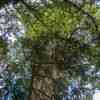When Is the Best Time
The Guanwu National Forest Recreation Area is always worth visiting, but you should try to avoid the typhoon season which is most likely to happen from July to September. Guanwu is famous for incredibly beautiful sunrises and sunsets at the end of the Leshan Forest Road close to the parking of the second trail entrance to the giant Formosan Trees. The other popular spot is on the top of the Jehnshan Trail. The views are spectacular on clear days. The very best time for it is the equinox in spring on March 21st and autumn on September 23rd. Anyhow, the sunlight has a minimal variation from summer to winter; rising from 5.06 to 6.42 am and setting between 5.09 to 6.48 pm.
Check out my new Taiwan Guide - Must know destinations, sunrises, hikes, and tips
Seasonal Highlights
- Spring

In March the almost 100 years old Wushe Cherry Tree is white blooming. From April to June the whole area is covered in blooming rhododendrons, azaleas as well as red Taiwan Cherries. This is an outstanding time for a visit.
-
Summer

Rare flowers are in bloom at this time of the year. You may spot the rare Broad-tailed Swallowtail Butterfly in June. Anyhow, bear in mind from July to September typhoons can occur and it rains frequently.
- Autumn
The foliage of the maple trees is fiery red.
- Winter

The mountain ridge called Holly Ridge is often covered in snow in January and February. These are the driest months of the year.
Taiwan's climate is subtropical, usually with wet and humid summers. Snow is common during winter mostly in January and February in high elevation. Most precipitation occurs from April to July. There is less rain from August to November and the driest months are December until March. Yet, even in the driest season, you can expect rain. During summer it's refreshing cool on 2000 meters elevation. Guanwu is located in the mid-altitude fog belt; it’s often misty. Frequently clouds and fog roll in in the afternoon.
Best Months to Visit
Location and Tips

Guanwu National Forest Recreational Area is located at 2000 to 2.500 meters above sea level between Wufeng and Hsinchu County. It is part of the Shei-Pa National Park; one of Taiwan’s eight National Parks. There are three different Recreational Areas within the Shei-Pa National Park. Guanwu was established in 1995 after many decades of logging and afforestation. Free entrance to the park.
Highlights
- Only a few giant Formosan Cypresses which are two thousand years old still exist. You can hike to five of them on the Kuaishan Trail.

- Guanwu is also famous for the Jhenshan or Zhenshan Trail to watch a jaw draping sunrise and the sea of clouds.

- The Guanwu Formosan Salamander, a living fossil existing for more than 180 million years.
Hiking Trails
To get all the needed details for hiking, make a stop at the excellent Information Center. They provide you with a map which is in Chinese and English. The staff is very attentive, but very few speak English quite well.
- Kuaishan Big Trees Trail – 5 giant and tall Formosan Cypresses around 2000 years old; the trail is 4 km long in one direction. There are two trailheads to start from. In November 2017 the trail entrance close to the Visitor Center was closed due to damages from a landslide after the last typhoon. You get much faster to the trees from the second entrance. It’s a steep trail down some parts with steps through a lush rainforest full of lichen to the first tree. The roundtrip is almost 3 km long, but due to the steep ascent on the way back, it takes 1 ½ to 2 hours.

- Jhenshan or Zhenshan Trail also called Hazelnut Mountain takes half a day and is famous for spectacular sunrises. The trail itself is 4 km long, but you need to walk to the trailhead another 2 km and also back. If you start the hike in darkness to watch a sunrise it is advisable to hike counterclockwise for a gentle ascent and a steep descent. If hiking in the daytime; it’s easier to walk clockwise the steep path up and the gentle trail down as we did. Bring enough water and a picnic for the top of the mountain on 2.487 m above sea level.

- Guanwu Waterfall Trail; the trail is roughly 3 km long and takes around 1 ½ hours due to the altitude difference of almost 300 meters. The descend is deep down with steep stepped sections.
Where to Stay
Nowadays, there are cabins to stay inside the park directly at the trailhead to Jhenshan or Hazel Mountain and the Botanical Garden. These cabins formerly the employee dormitory of the Forestry Bureau were renovated at the end of 2017. There is also a restaurant and café for overnight guests and day-trippers. Unfortunately, they were not finished in November, so we camped an hour away.
The closest alternative for staying in proximity to Guanwu is the popular Shei-pa Lodge or Sheipa Leisure Farm
Getting to Guanwu
Guanwu is 2.5 hours drive from New Taipei. There are only two options to get there; either by an organized tour or by rental car. There isn’t any public transport offered. The 122 is a winding and narrow road which joins up into Dalu Forest Road to Guanwu. That's the reason that it takes hours to get there. Offered tours begin either very early in the morning, or you spend a night at the Shei-pa Lodge to watch the sunrise.























































































































